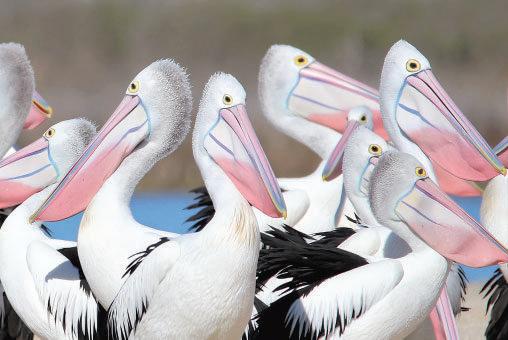
3 minute read
Unfastens
Citizen scientists help the count
RESULTS from the 2022 Gippsland Lakes Great Pelican Count are in. Almost 100 participants took part in this year’s annual BirdLife Australia Gippsland Lakes Great Pelican Count, recording 1135 pelicans in 30 minutes on a cloudless Sunday in April. Citizen scientists gathered at 77 locations to raise their binoculars for the environment, recording 476 more pelicans than in 2021 and 500 more than the previous count held in 2019. Of the 1135 pelicans recorded, 75 per cent were roosting, 10 per cent were moving, and 15 per cent were noted as foraging or scavenging for food. BirdLife Australia project coordinator Deb Sullivan said the organisation was delighted with this year’s participation and results. “Recent wet weather has meant that there have been more fish to be had and have provided great feeding and breeding conditions for the pelicans,” Ms Sullivan said. “It’s an important 30 minutes of the year as the results provide a ‘pelican snapshot’ and contributes to the larger, ongoing pelican monitoring and protection program across the Lakes. “The event is definitely not stand alone; the wonderful citizen scientists help build the bigger picture of pelican population dynamics that ultimately leads to understanding better ways to manage and protect them. “It’s also about simply getting out, being together and enjoying the Lakes and its incredible landscapes and wildlife. “There were people of all ages counting on the day including staff from East Gippsland and West Gippsland Catchment Management Authorities. Also, for the first time this year, residents of Mallacoota participated in the count and I thank everyone for their enthusiasm.” Ms Sullivan and her team place bands on the pelicans across the year to track their movements and activity, with 37 young birds tagged so far this year. The team can track the birds in real-time with satellite trackers, and is planning to deploy 10 more tracking devices onto adults and juveniles in the near future. “This year, two red and white coloured leg banded pelicans were recorded during the count, ” Ms Sullivan said. “This is the colour unique to the Gippsland Lakes, with green and white bands being the colour that is unique to Western Port and Port Phillip bays. “It’s not only interesting to know where pelicans go, but it helps us understand their behaviour better, the habitats they like to use, and improves management practices for the future of the species.” Bands and trackers have recorded birds from the Lakes in Batemans Bay and Eden. It is more common for the birds to stay in their territorial areas and home ranges, proving that pelicans, like humans, love our lakes. The count may be over, but you can be a pelican citizen scientist all year round. Simply snap a picture on your phone and record any pelicans with coloured leg bands you see, noting the date, time, and location of your sighting and note if the pelicans were alone or how many other birds they were with. Submit any sightings to greatpelicancount@ birdlife.org.au or on the ‘Love Our Pelicans’ Facebook page set up to follow project research, share stories, photos, and report sightings of banded pelicans. Search for ‘Love our Pelicans’ on Facebook to join. The Gippsland Lakes Great Pelican Count is an initiative of BirdLife Australia, supported by East and West Gippsland Catchment Management Authorities. The program is funded as part of the state government’s $248 million investment over four years (2020-2024) to improve the health of waterways and catchments across regional Victoria, and made possible through $7.5 million to support the Gippsland Lakes Coordinating Committee and deliver onground works and community engagement.
Advertisement
Pelicans at Lakes Entrance.
Pip Masters Alison Green and Max Eliot in this year’s Gippsland Lakes Great Pelican Count.










